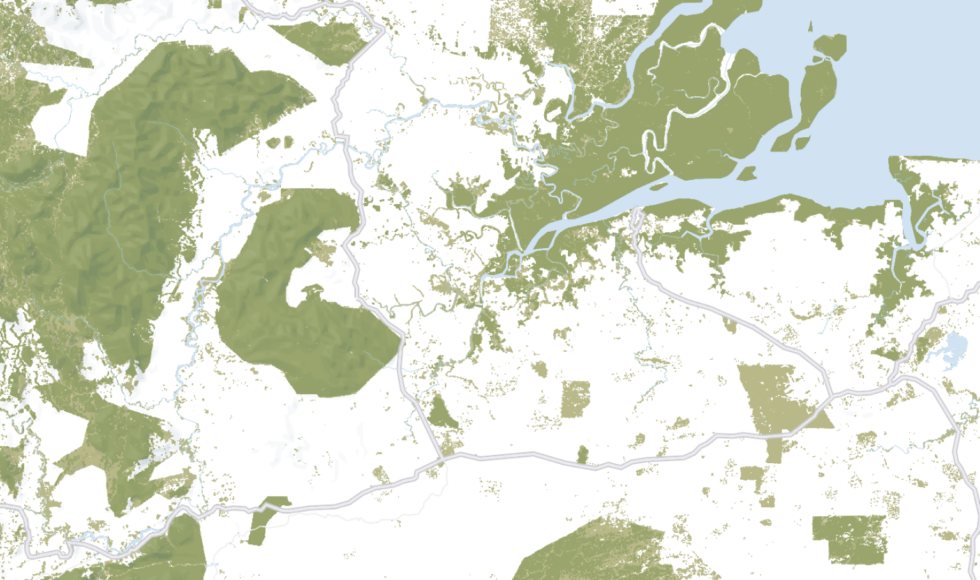Our goal at Satelligence is to stop deforestation. The last thing we want is to drown our clients in data watering down their attention while slowing down decision making processes aimed to stop deforestation. Therefore we develop algorithms, and yes, we use AI to reduce enormous amounts of data into discussion ready data. Data that feeds a decision making discourse, leading to actions in the real world that affect the chain of events that have caused forest loss.
But how do you get from data to actions? Especially when there is a lot of data?
Herbert Simon, Nobel laureate in 1971, said:
“A wealth of information creates a poverty of attention.”
This paradox creates a problem for, for example, sustainability managers at large corporations who need actionable information to tackle deforestation related activities in their supply chain. The information is there, but there is too much of it. It leads to poverty of attention rather than action. The sustainability manager is drowning in data, drowning in information.

In a world where increasingly more information becomes available, the information overload problem becomes bigger and bigger. For us, as a Remote Sensing company trying to contribute to deforestation free commodity supply chains, the increase in data availability is both an opportunity and a problem.
The opportunity being that with the current state of freely available algorithms and computing power, combined with ninja engineering and data science teams, those information streams can be reduced to bite sized solutions: actionable insights, or, Discussion Ready Data. Our technical teams are building and extending our engine that can efficiently process humongous amounts of data. That engine ensures that new data streams can be integrated efficiently leading to higher quality information rather than more information: a high quality solution providing actionable insights.
The problem is:
What does that solution actually look like?
And how is that information actionable? Pivotal here is to stop thinking from a data perspective and start thinking from a client perspective. Our customer team is in constant contact with clients and the market to understand their pains and needs.
The catch here is in the difference between efficiency and effectiveness:
- Efficiency is doing things right (engineering and data science teams)
- Effectiveness is doing the right things (customers team)
Together, those teams form a service development machine that maps and implements customer requests to production ready methods in a structured way. Very much like the standard ‘agile’ methods are based on user stories, we develop our features with a similar approach. But with a twist: we not only focus on the internal workflow of organisations but also on their position and relation to other organisations. Their role and place in the larger context, or ecosystem.
Therefore, it’s important not to stop after finding the solution to a problem but continue to focus on the actionable part of actionable insights. What changes after the client adopts or implements the service or product? In which direction does the world move when people start using the service or product?
We call it story based development and is best brewed with the following ingredients:
- Problem
- Solution
- Action
Problem
All too often, the tech scene makes solutions and then looks for problems to solve with that solution. We rather start with why, with the problem. Why does a client have the pain they have? What is the actual pain they feel? Is that pain their biggest problem, or is there a deeper root cause? Having offices in Utrecht, Jakarta, Accra, Arusha and La Paz allows us to be close to our customers. Understanding the local political, economical, social and historical context is key in mapping commodity production related problems.
Solution
After the problem is sufficiently understood, we design a solution. Crafting the solution often starts with visuals: graphs, tables, report layouts, web page designs. UI / UX design is imperative here. Visuals are tested with clients at an early stage so we quickly can get feedback. Simultaneously, the data science and or engineering team picks up the design of the technical part of the solution.
This is where the technical teams shine. Having mapped customer requests in a structured way, the data science and engineering teams design a solution that fits the problem. Once we understand the customer problem, we select the best earth observation analytics to craft a scalable solution.
This way we have a double, interlocking feedback loop (double funnel, if you wish) running iterating over solution design and implementation That way we can have ideation (sketch), prototyping (proof of concept) and implementation (operational service) going on, all at the same time, resulting in a very short Time To Market.
Action
Action. This is where we are really different from other players in the field. We are not satisfied with our data ending up in /dev/null. We care about the planet so we really want our data to be used in meaningful discussions, leading to effective actions.
If you want your service to be used in a meaningful way you first have to understand the workflow of the clients which incorporate your service. But you also have to understand the larger ecosystem of complex relations they are part of to put that workflow into context. Organisations don’t exist in and for themselves. They exist in a context, in relation to other organisations that determines and influences the way they act.
To understand that larger ecosystem, we study and participate in that ecosystem. We map supply chains, visit events, partner with NGO’s, stay in close contact with campaigning organisations and we keep good relations with government institutions. This creates contextual intelligence which we exploit to implement solutions that work in particular local contexts.
Understanding both the internal workflow of our clients and their role and place in the larger ecosystem is something we put a lot of effort in. This already starts during the awareness and consideration phases of the customer journey. Our support and nurturing programs make sure we keep in close contact with our clients during the service phase. Apart from observing the planet, we keep listening to our customers.
We are not satisfied when we find a solution to a client’s problem and stop there. We are not satisfied with our reports and data ending up in drawers, never to be looked at again. We want people to really use our products and services continuously.
